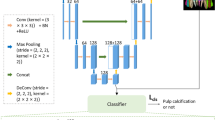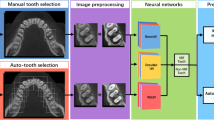Abstract
To evaluate the effect of deep learning model on cone beam (CB) CT image analysis of patients with acute pulpitis. The improved principle of maximum entropy and minimum energy method (PME-MEM’) was proposed to preprocess CBCT images. The conditional generative adversarial network (cGAN) model of deep learning was adopted to segment images. In this study, 80 cases of acute pulpitis in our hospital were selected as the research objects. CT images of the patients were collected and pretreated with PME-MEM. The denoising effects of different Gaussian noise treatments were compared and analyzed, and cGAN model was used to segment different parts of teeth in the image. The treatment plan was made according to the processed CT images, and patients were rolled into two groups according to the treatment methods, with 40 cases in each group. The modified group received one-off root canal treatment, and the traditional group received multiple root canal treatments. The postoperative treatment effects of the patients were observed. The results showed that the PME-MEM’ had a better denoising effect on CBCT images relative to the original PME-MEM. The deep learning cGAN model can realize the segmentation of caries, enamel, dentin, dental pulp, crown, restoration, and root canal in CBCT images. The clinical treatment results showed that the treatment time and postoperative pain score of the modified group were considerably reduced versus those of the traditional group (P < 0.05). The postoperative comfort score and satisfaction with treatment results increased greatly (P < 0.05). In short, deep learning can be used to segment the target position in CBCT images of patients. Combined with one-off root canal therapy, the therapeutic effect was ideal for patients with acute pulpitis.











Similar content being viewed by others
References
Madurantakam P (2019) Is calcium hydroxide more effective than formocresol or camphor phenol as intracanal disinfectants in acute pulpitis among deciduous teeth? Evid Based Dent 20(3):86–87. https://doi.org/10.1038/s41432-019-0044-3
Evangelin J, Sherwood IA, Abbott PV, Uthandakalaipandian R, Velu V (2020) Influence of different irrigants on substance P and IL-8 expression for single visit root canal treatment in acute irreversible pulpitis. Aust Endod J 46(1):17–25. https://doi.org/10.1111/aej.12340
Tampi MP, Pilcher L, Urquhart O et al (2019) Antibiotics for the urgent management of symptomatic irreversible pulpitis, symptomatic apical periodontitis, and localized acute apical abscess: systematic review and meta-analysis-a report of the American Dental Association. J Am Dent Assoc 150(12):e179–e216. https://doi.org/10.1016/j.adaj.2019.09.011
Mohammadi Z, Abbott PV, Shalavi S, Yazdizadeh M (2017) Postoperative pain following treatment of teeth with irreversible pulpitis: a review. N Y State Dent J 83(1):44–53
Zhang W, Dai YB, Wan PC, Xu DD, Guo Y, Li Z (2016) Relationship between post-extraction pain and acute pulpitis: a randomised trial using third molars. Int Dent J 66(6):325–329. https://doi.org/10.1111/idj.12249
Huang J, Lv Y, Fu Y et al (2015) Dynamic regulation of delta-opioid receptor in rat trigeminal ganglion neurons by lipopolysaccharide-induced acute pulpitis. J Endod 41(12):2014–2020. https://doi.org/10.1016/j.joen.2015.09.011
Gemmell A, Stone S, Edwards D (2020) Investigating acute management of irreversible pulpitis: a survey of general dental practitioners in North East England. Br Dent J 228(7):521–526. https://doi.org/10.1038/s41415-020-1419-8
Bane K, Charpentier E, Bronnec F et al (2016) Randomized clinical trial of intraosseous methylprednisolone injection for acute pulpitis pain. J Endod 42(1):2–7. https://doi.org/10.1016/j.joen.2015.09.003
Huang JI, Chang HH, Lin CP, Liao WC, Kao CT, Huang TH (2018) Trigeminocardiac reflex during non-surgical root canal treatment of teeth with irreversible pulpitis. J Formos Med Assoc 117(6):512–517. https://doi.org/10.1016/j.jfma.2017.05.010
Moen E, Bannon D, Kudo T, Graf W, Covert M, Van Valen D (2019) Deep learning for cellular image analysis. Nat Methods 16(12):1233–1246. https://doi.org/10.1038/s41592-019-0403-1
Lai YH, Tsao Y, Lu X, Chen F, Su YT, Chen KC, Chen YH, Chen LC, Po-Hung Li L, Lee CH (2018) Deep learning-based noise reduction approach to improve speech intelligibility for cochlear implant recipients. Ear Hear 39(4):795–809
Pedemonte E, Cabrera C, Torres A et al (2018) Root and canal morphology of mandibular premolars using cone beam computed tomography in a Chilean and Belgian subpopulation: a cross-sectional study. Oral Radiol 34(2):143–150. https://doi.org/10.1007/s11282-017-0297-5
Lopez LD, Shantharaj D, Liu L et al (2011) Robust image-based 3-d modeling of root architecture. Proc Comput Graph Int 30(2):141–149. https://doi.org/10.1007/s11282-017-0297-05
Chambers EW (2017) Burning the medial axis. CCCG 12(9):3–9. https://doi.org/10.1007/s11282-017-0297-01
Li YH, Bao SJ, Yang XW, Tian XM, Wei B, Zheng YL (2018) Symmetry of root anatomy and root canal morphology in maxillary premolars analyzed using cone beam computed tomography. Arch Oral Biol 94:84–92. https://doi.org/10.1016/j.archoralbio.2018.06.020
Celikten B, Jacobs R, de Faria VK et al (2019) Comparative evaluation of cone beam CT and micro-CT on blooming artifacts in human teeth filled with bioceramic sealers. Clin Oral Investig 23(8):3267–3273. https://doi.org/10.1007/s00784-018-2748-8
Rashed B, Iino Y, Komatsu K et al (2018) Evaluation of root canal anatomy of maxillary premolars using swept-source optical coherence tomography in comparison with dental operating microscope and cone beam computed tomography. Photomed Laser Surg 36(9):487–492. https://doi.org/10.1089/pho.2017.4416
Gaêta-Araujo H, Fontenele RC, Nascimento EHL, Nascimento MDCC, Freitas DQ, de Oliveira-Santos C (2019) Association between the root canal configuration, endodontic treatment technical errors, and periapical hypodensities in molar teeth: a cone-beam computed tomographic study. J Endod 45(12):1465–1471. https://doi.org/10.1016/j.joen.2019.08.007
Zehnder MS, Connert T, Weiger R, Krastl G, Kühl S (2016) Guided endodontics: accuracy of a novel method for guided access cavity preparation and root canal location. Int Endod J 49(10):966–972. https://doi.org/10.1111/iej.12544
Author information
Authors and Affiliations
Corresponding author
Additional information
Publisher's Note
Springer Nature remains neutral with regard to jurisdictional claims in published maps and institutional affiliations.
Rights and permissions
About this article
Cite this article
Zhang, X., Zhu, X. & Xie, Z. Deep learning in cone-beam computed tomography image segmentation for the diagnosis and treatment of acute pulpitis. J Supercomput 78, 11245–11264 (2022). https://doi.org/10.1007/s11227-021-04048-0
Accepted:
Published:
Issue Date:
DOI: https://doi.org/10.1007/s11227-021-04048-0




